Adam Ferguson, Afghanistan, 2009
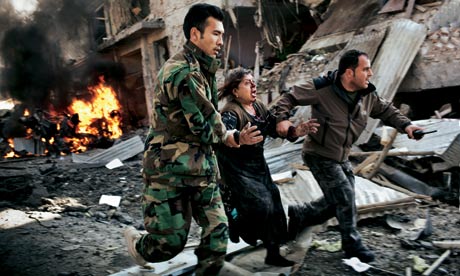 Adam Ferguson: 'As a photographer, you feel helpless. Around you are medics, security personnel, people doing good work. It can be agonisingly painful to think that all you're doing is taking pictures.' Photograph: Adam Ferguson/VII Network
Adam Ferguson: 'As a photographer, you feel helpless. Around you are medics, security personnel, people doing good work. It can be agonisingly painful to think that all you're doing is taking pictures.' Photograph: Adam Ferguson/VII Network
I was one of the first on the scene. The Afghan security forces normally shut down a suicide bombing like this pretty quickly. I was able to get to the epicentre of the explosion. It was carnage, there were bodies, flames were coming out of the buildings. I remember feeling very scared because there was still popping and hissing and small explosions, and the building was collapsing. It was still very fresh and there was a risk of another bomb. It was one of those situations where you have to put fear aside and focus on the job at hand: to watch the situation and document it.
This woman was escorted out of the building and round this devastated street corner. It epitomised the whole mood – this older woman caught in the middle of this ridiculous, tragic event. I wish I could have found out how her life unravelled, but as soon as the scene was locked down, I ran back to the office to file.
As a photographer, you feel helpless. Around you are medics, security personnel, people doing good work. It can be agonisingly painful to think that all you're doing is taking pictures.
When I won a World Press award for this photograph, I felt sad. People were congratulating me and there was a celebration over this intense tragedy that I had captured. I reconciled it by deciding that more people see a story when a photographer's work is decorated.
Alvaro Ybarra Zavala, Congo, November 2008
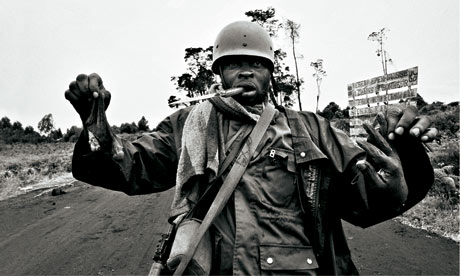 Alvaro Ybarra Zavala: 'Years after i took this picture, every time I see it I feel scared again.' Photograph: Alvaro Ybarra Zavala/Getty
Alvaro Ybarra Zavala: 'Years after i took this picture, every time I see it I feel scared again.' Photograph: Alvaro Ybarra Zavala/Getty
The situation was very tense – people were drunk and aggressive. I was with two other photographers most of the time, but at this moment I went back to the road alone. I saw three soldiers smoking, playing with their guns, and felt safe – I don't know why. Then I saw a man with a knife in his mouth, coming out of the bush – he was holding up a hand like a trophy. The soldiers started laughing and firing in the air. I didn't think about it and began shooting. He walked directly at me. People surrounded us, celebrating. I thought, "Don't do anything crazy, just act like you're part of this crazy party."
When I got to the hotel, I showed the other photographers. They said, "Do you realise you could have been killed?" Only then did it hit me how dangerous it had been. Years after I took this picture, every time I see it I feel scared again.
I really hate this shot. It's the worst face of humankind. I always ask myself, "Why do I do this job?' And the answer is: I want to show the best and worst face of humankind. Every time you go to a conflict, you see the worst. We need to see what we do to be able to show future generations the mistakes we make. The guy with the knife in his mouth is a human being like the rest of us. What's important is that we show what human beings are capable of. The day I don't do that with my photography is the day I'll give up and open a restaurant.
Greg Marinovich, Soweto, 1990
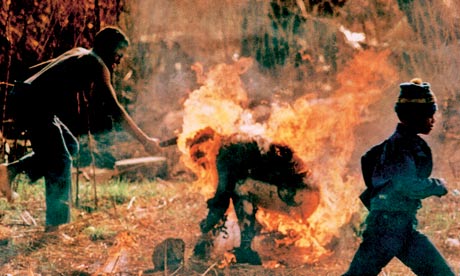 Greg Marinovich: ' "No pictures," someone yelled. I told them I'd stop shooting if they stopped killing him. They didn't.' Photograph: Greg Marinovich/Storytaxi.com
Greg Marinovich: ' "No pictures," someone yelled. I told them I'd stop shooting if they stopped killing him. They didn't.' Photograph: Greg Marinovich/Storytaxi.com
I was deep in Soweto when I saw a man being attacked by ANC combatants. The month before, I'd seen a guy beaten to death – my first experience of real violence – and hadn't shaken the feeling of guilt that I had done nothing to stop it. "No pictures," someone yelled. I told them I'd stop shooting if they stopped killing him. They didn't. As the man was set on fire, he began to run. I was framing my next shot when a bare-chested man came into view and swung a machete into his blazing skull. I tried not to smell the burning flesh and shot a few more pictures, but I was losing it and aware that the crowd could turn on me at any time. The victim was moaning in a low, dreadful voice as I left. I got in my car and, once I turned the corner, began to scream.
You're not just a journalist or a human being, you're a mixture of both, and to try to separate the two is complicated. I've often felt guilty about my pictures. I worked in SouthAfrica for years and was shot three times. The fourth and final injury, in Afghanistan in 1999, wasn't the worst, but I decided enough was enough. I was looking to settle. Nineteen months later, I met my wife.
Shaul Schwarz, Haiti, February 2004
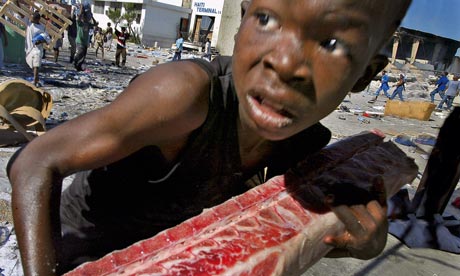 Saul Schwarz: 'I had blood on me, brains. I was crying, shaking. I ran to the car horrified. I was a mess.' Photograph: Shaul Schwarz/Getty
Saul Schwarz: 'I had blood on me, brains. I was crying, shaking. I ran to the car horrified. I was a mess.' Photograph: Shaul Schwarz/Getty
Port au Prince was falling. It was riotous, with widespread looting. A group of us had gone to the port. The thugs with guns didn't want us there. We snapped from the waist, trying not to make it obvious. We decided to go over the wall. One thug offered me "protection". As we jumped the wall, I saw this boy, and was like, "This is what it's come to." It was my first digital assignment and I was amazed to be able to look at my shots. I did for a second; when I looked up, everyone had run off. It was just me and the thug. It was like a dog that smells fear. He began pushing and threatening me. Then I was surrounded. One of them hit me. I had a few dollar bills in my trousers, and put my hand there. They began tearing at me, fighting over the bills. I waited 30 seconds, started to walk away, then ran and scaled the fence. On the other side, I tried to breathe.
I began shooting one guy a metre away. He screamed and pulled a shotgun. I saw the barrel, then he shot the man next to me – I had blood on me, brains. I was crying, shaking. I ran to the car horrified; I was a mess. I love Haiti, but every time I pass the port, I carry some of that fear.
Mads Nissen, Libya, February 2011
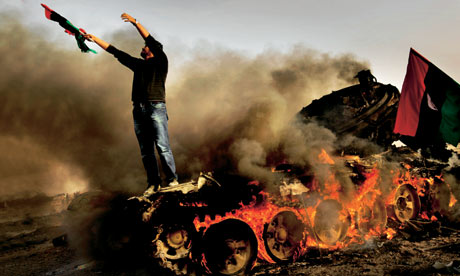 Mads Nissen: 'Suddenly this guy jumped on the the tank. I'm not that interested in pictures of tanks burning – I'm interested in people. I had wanted to capture the sense of release that everyone had, and this became the shot.' Photograph: Mads Nissen/Berlingske/Panos Pictures
Mads Nissen: 'Suddenly this guy jumped on the the tank. I'm not that interested in pictures of tanks burning – I'm interested in people. I had wanted to capture the sense of release that everyone had, and this became the shot.' Photograph: Mads Nissen/Berlingske/Panos Pictures
I got into Ajdabiya shortly after its fall. The rebels had just moved in and the locals were going crazy, shooting in the air. Bodies of pro-Gaddafi soldiers were lying around, beginning to stink as the sun got higher. The fire from the tank was incredibly strong and I was worried it might explode at any moment. Suddenly this guy jumped on to it. I'm not that interested in pictures of tanks burning – I'm interested in people. I had wanted to capture the sense of release that everyone had and suddenly this became the shot. I got as close as possible, within metres, and started shooting, counting to five in my head. Then I got out. I had seen corpses, torn apart, in the morgue and didn't want to end up like that. I took a chance – I had to; that was why I was there, to tell the story – but I made sure I wasn't too greedy.
Ron Haviv, Bosnia, 1992
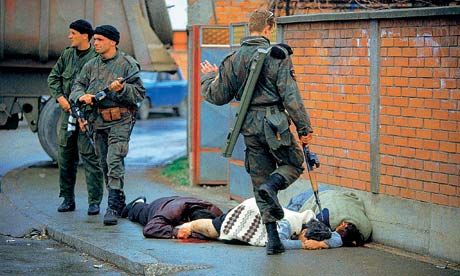 Ron Haviv: 'I was shaking when I took the shot. None of them was looking at me, so I lifted my camera, just trying to get them in frame. When I put it down, they looked over. They didn't realise I'd taken photos.' Photograph: Ron Haviv/VII
Ron Haviv: 'I was shaking when I took the shot. None of them was looking at me, so I lifted my camera, just trying to get them in frame. When I put it down, they looked over. They didn't realise I'd taken photos.' Photograph: Ron Haviv/VII
These are the Serbian warlord Arkan's men. They've just executed these Muslim civilians – a butcher, his wife and sister-in-law; the start of what became known as ethnic cleansing.
I had taken a photograph of Arkan with a baby tiger, which he'd liked, and he'd agreed for me to travel with his troops to photograph his "mission". The soliders were yelling at me not to shoot, but I'd promised myself I'd come out of this with an image to prove what was happening.
I was shaking when I took this shot. None of them was looking at me so I lifted my camera, just trying to get them in frame. When I put it down, they looked over. They didn't realise I'd taken photos.
Later, Arkan caught me photographing another execution and said he'd process my film and keep the ones he didn't like. I'd hidden the film from earlier in the day in my pocket and figured that if I fought hard enough for the film in my camera, he wouldn't search me.
When the pictures were published not long after, Arkan said in an interview, "I look forward to the day I can drink his blood." He put me on a death list, and I spent the next eight years trying to avoid him. Eventually, these images were used to indict him at The Hague.

No comments:
Post a Comment